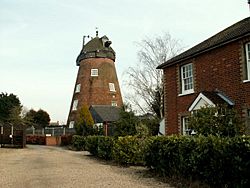Messing Maypole Mill facts for kids
Quick facts for kids Tiptree Mill |
|
|---|---|

The converted mill, March 2006
|
|
| Origin | |
| Mill name | Messing Maypole Tree |
| Mill location | TL 894 167 |
| Coordinates | 51°49′01″N 0°44′46″E / 51.817°N 0.746°E |
| Operator(s) | Private |
| Year built | 1775 |
| Information | |
| Purpose | Corn mill |
| Type | Tower mill |
| Storeys | Four storeys |
| No. of sails | Four sails |
| Type of sails | Double Patent sails |
| Windshaft | Cast iron |
| Winding | Fantail |
| Auxiliary power | steam engine, then electric motor |
| No. of pairs of millstones | Three pairs |
The Messing Maypole Mill is a historic Tower mill located in Tiptree, Essex, England. It is a Grade II listed structure, which means it's an important building protected for its special interest. This old mill has been transformed into a home. Before 1934, when the area of Tiptree became its own civil parish, the mill was part of the nearby Tolleshunt Knights parish.
Contents
The Mill's Story: A Timeline
The Messing Maypole Mill was built in 1775. A millwright named John Mathett from Colchester constructed it. It cost £315, not including the brickwork. Mathett also rebuilt another type of windmill, a post mill, located close by. The £315 cost might have included work on both mills.
Early Owners and Changes
Mathett owned the mill until 1797. Then, a miller named Thomas Green bought it. When Green passed away in 1806, Edward Harvey took over the mill. Harvey died in 1829, and another miller, James Peake, purchased it. Peake faced financial difficulties and was declared unable to pay his debts in 1845. The mill was then sold by those managing his affairs.
George Ransom became the next miller. He brought in steam power to help run the mill. After Ransom's death in 1884, his wife managed the mill for a few years. Later, Henry Cattermole took charge.
Modernizing the Mill
In 1890, the millwright Bryant from Colchester made an important upgrade. He replaced the old wooden shaft that held the sails with a stronger Cast iron one. This new shaft came from another mill in Roxwell. Bryant might also have added the fantail around this time. A fantail is a small windmill at the back of the cap that automatically turns the main sails into the wind.
Milling using wind power stopped around 1911. During World War I, the mill was powered only by steam. In the 1920s, Frederick King got the mill working fully again. However, the large sails were finally removed in February 1927, leaving only the main supports.
The Mill's Final Working Years
The mill continued to grind grain until at least 1962. The heavy millstones, which grind the grain, were taken out in 1960. By this time, the mill was powered by electricity. In 1969, the Messing Maypole Mill was converted into a home, giving it a new purpose after centuries of grinding corn.
What the Mill Looks Like
The Messing Maypole Mill is a four-storey brick Tower mill with a rounded, dome-shaped top, called a cap. When it was first built, it had four Common sails on a wooden shaft. It was turned into the wind by hand. There was also a platform, or stage, at the first-floor level.
The base of the tower is about 27 feet 6 inches (8.38 meters) wide. It gets narrower towards the top, measuring about 14 feet 6 inches (4.42 meters) wide at the curb level (where the cap sits). The tower itself stands about 42 feet 6 inches (12.95 meters) tall to the curb. The entire mill, up to the decorative top of the cap, is about 55 feet (16.76 meters) tall. The cap was later turned by a fantail, which was placed over a back extension that used to hold the hand-winding equipment. The brick walls are about 4 feet (1.22 meters) thick at the base and 22 inches (559 millimeters) thick at the top.
Inside the Mill: The Machinery
Inside, the mill had a large wooden Brake Wheel that was 10 feet (3.05 meters) across. This wheel had 72 teeth and was mounted on the cast-iron shaft that once held the four large sails. The brake wheel turned a wooden Wallower gear. This wallower was on a long wooden Upright Shaft that was about 31 feet (9.45 meters) long.
At the bottom of the upright shaft, a large wooden Great Spur Wheel turned. This wheel was about 9 feet 2 inches (2.79 meters) wide and had 84 teeth. In its later working years, the mill operated three pairs of millstones to grind grain.
Who Ran the Mill: The Millers
Here are some of the people who operated Messing Maypole Mill over the years:
- Thomas Green: 1776–1806
- James Peake: 1806–1848
- George D Ransom: 1848–1884
- Mrs. Ransom: 1884–1887
- Henry Cattermole: 1887–c1911
- Frederick King: 1922–1937

